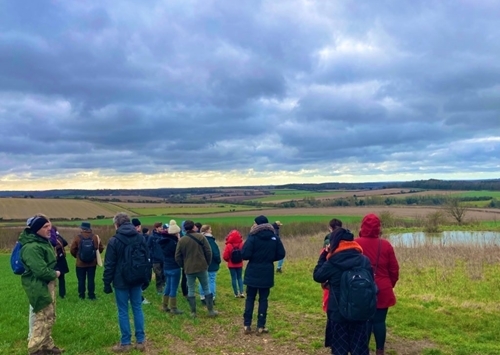Farmers are increasingly being asked to produce more with less, and seeing this impact on both farming communities and the environment, many are looking for an alternative to a race to the bottom. The GWCT is well known for facilitating and aiding the development of more than 100 Farmer Clusters in England with great success, which has continued in earnest with the FRAMEwork project. The project has helped develop and support 11 Farmer Clusters across nine European countries, aiming to improve the landscape-scale management of farmland wildlife. Each Farmer Cluster has its own focus and approach, with organic, conventional, and mixed farms all represented.

If you’ve been keeping up with the project, you’ll know that the team spent last year’s fieldwork season collecting baseline biodiversity data. Now in their second year of fieldwork for the project, the team have been busier than the farmland bees they survey. In addition to extensive farmland bird and pollinator monitoring, they have also completed botanical surveys and nest-box checks for the next generation of barn owls on Cranborne Chase, the GWCT-led FRAMEwork Farmer Cluster in England. To try to better understand what impact different approaches to farming have on the farm itself and the wider environment, they have also been working with farmers to assess water usage, nitrogen availability, and the carbon footprint of farms.
At its heart, FRAMEwork is about sharing ideas, inspiring new approaches, and collaborating to make farmland biodiversity conservation possible on the ground. This occurred in March when the GWCT team hosted the projects’ annual meeting. Around 50 people from across the European partner organisations were invited to the Martin Down Farmer Cluster with GWCT advisors past and present to look across the cluster and see what a successful, long-established Farmer Cluster could look like. With the GWCT team’s expertise, they showcased the best of Farmer Clusters in the hope of inspiring other cluster facilitators, allowing them to see and experience first-hand what this collaboration looks like on the ground and what the journey from separate farms into Farmer Clusters looks like. While the group looked over the patchwork of farmed land and wildlife habitats such as dew ponds and grey partridge mixes visible across the valley, the team also talked to the group about the cluster, how it has overcome challenges, and how they could encourage farmers to take part in their clusters.
Knowledge sharing continued for another two days, with the group providing updates about their respective clusters and their work to monitor biodiversity and engage people in that process. Trust staff and Farmer Cluster facilitators attended, showcasing the range of management priorities, approaches to collaborative work, and funding channels seen in Farmer Clusters across England, with examples from the Avon Valley and Devon highlighted. The team also led discussions about the kinds of technology we can make available and accessible to farmers to help empower them to set their priorities for their cluster and harness and organise the data they are collecting.
With another year of biodiversity monitoring ahead of them in 2024 before the project moves into its next phase, the team is working hard to share what they have learned so far and ensure that this knowledge ends up in the hands of farmers. To keep up with the project and its findings, visit the FRAMEwork website and consider subscribing to our Farming Newsletter.
